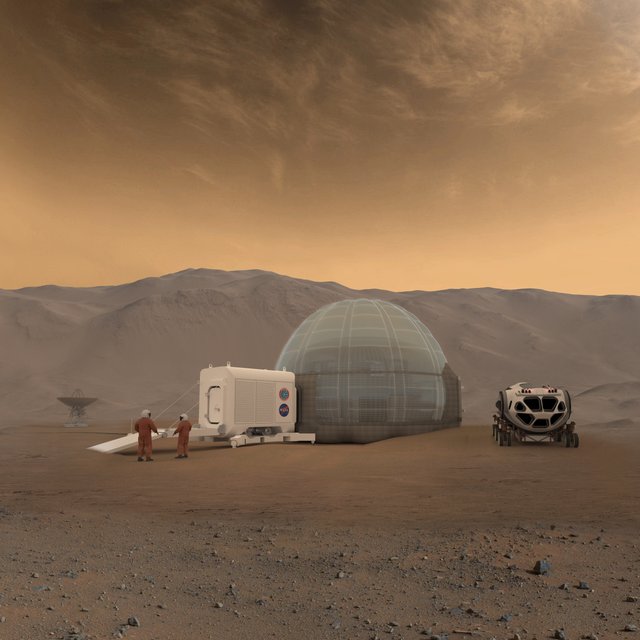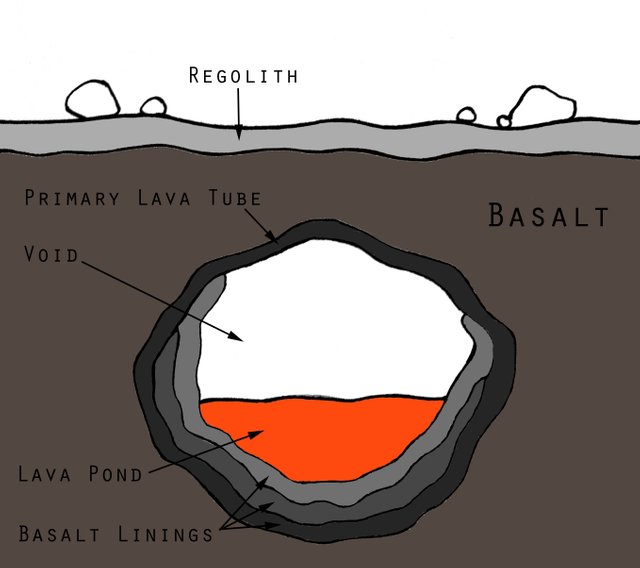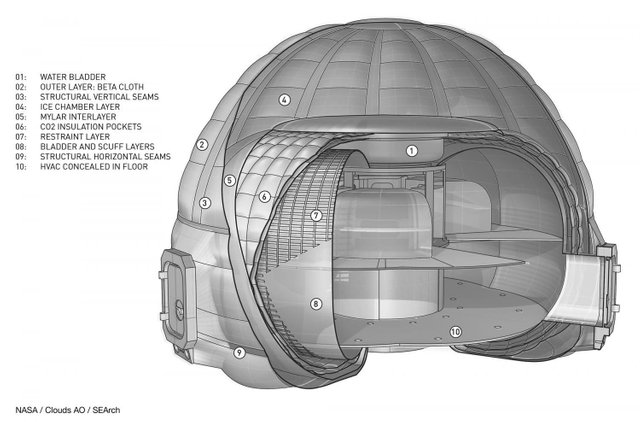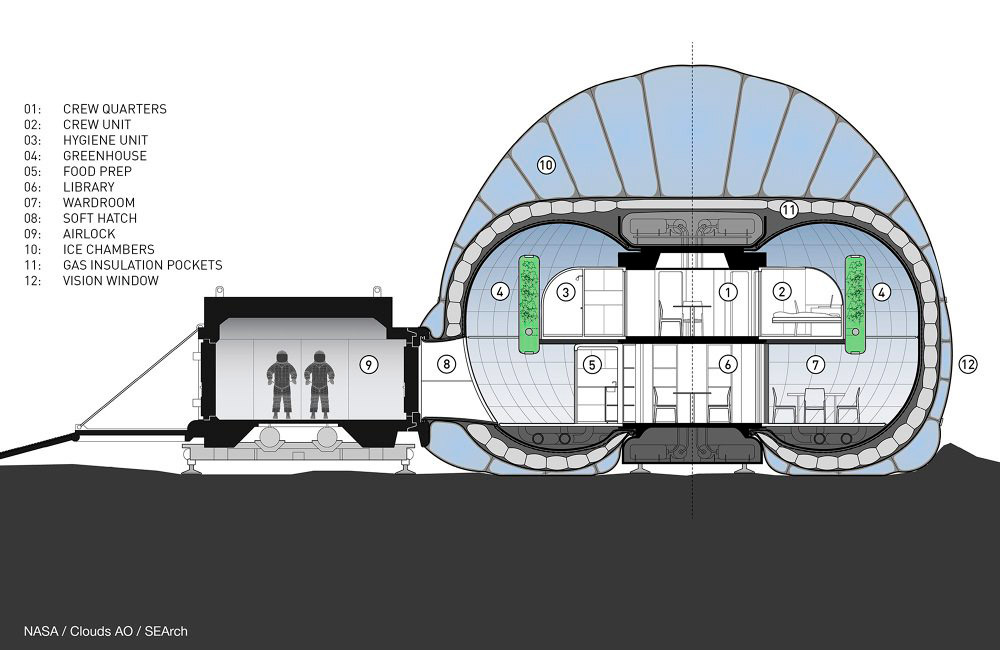The science of MARS habitats (surviving the un-survivable) - Colonization of MARS Series
Living in the most inhospitable place to date will surely be an amazing feat of science and engineering.
I was disappointed by my last article's coverage of actual Mars habitats (a single lousy paragraph) and I wanted to include something more. I have also tried a different, I hope, friendlier approach, in the scope of attracting more readers from all backgrounds.
I will be your guide in this endeavor, trying to compile an easy to read Mars Colonization Handbook. Previously in our imaginary journey we have learned how to launch, orbit, achieve a Mars Insertion Orbit, and land (safely). We have talked about power generation, producing water, oxygen and nutritional sustenance and even fuel to return to earth without having to carry the return fuel. We have discussed about radiation protection and today we will explore the technology required to make us live on Mars.

A rendering of a possible Mars habitat, called Ice Home, credited to NASA's Langley Research Center

Features of the ideal Mars Habitat
- A lightweight structure, ideally placed on the surface to keep the explorers' or colonists' mental health positive.
- Inflatable structure would further reduce the cargo space occupied
- Using local materials for thermal and radiation insulation would reduce its launch mass from Earth
- Natural light would offer a great reduction in energy consumption
- Portability should also be taken into consideration as we might discover other areas of interest and relocation might be necessary at least in the beginning phases
- Excellent radiation protection during Solar Flares or Solar Storms
- Easy access to the habitats and ideally a way to have an oversight of the habitats from orbit or even from Earth
Habitats in the lava tubes
We will first explore the basic habitat solution, inside already formed lava tubes. A lava tube is either created by lava flows close to the surface which solidify the outlying crust and erupts at the point of least resistance or by lava making its way through the crust in a long period of time, creating huge networks of caves and canals in its search for the weakest point in the regolith. The low gravity also plays a big role as the resulting lava tubes can be up to 10 times bigger than on Earth. This creates huge chambers and large connecting canals.
A study made by University of Padova and the University of Bologna compares the lava tubes on Earth, Mars and the moon and comes to the conclusion that whole cities could be fitted inside.
The difficulty would be finding such lava tubes in the first place, as the current technology is insufficient. Scouting of the lava tubes will have to be done IN-SITU, using drones and rovers. Advantages of the lava tubes as habitats are the fact that if we settle in a vast network of lava tubes we would be able to develop a cheap transit system, with minimal additional protection against radiation or weather. A healthy and fast transit system will be paramount for the mining operations and for the scouting of new areas.
Underground, the temperature will also fluctuate less, putting even less stress on the materials and the associated welding points. This translates into cheap infrastructure. By using LED lighting with intelligent sensors, sufficient lighting could be used when it is needed. The surface could be used by mining rovers and energy sources and little exposure will be necessary. Habitats could be drilled into the walls and stacked on top of another due to the limited gravity. Materials used could be very light and very easy to ship and by using the technology available to us since the early metal age, we could easily build habitats in great numbers. We have a history of building underground, one of the best examples is Kaymakli Underground City, in Turkey, built in the 8th–7th centuries B.C.E. We have since advanced technologically quite a bit :)


Kaymakli Underground City, a huge underground complex with individual homes and an integrated ventilation system.
By using the local regolith and minerals we could actually "plug" and isolate a section of the lava tubes and then coat the permeable walls with mortar and even try to pressurize the interior. All of this is done using the local materials and the technology available to us even before the industrial age, so imagine what a team of highly trained engineers might be able to do given enough time and robotic help. Also don't forget that any engineer could lift up to 3 times more than on Earth. This is something that the ancient people couldn't do in Turkey.
Now think of even more help for the explorers. Think about locating an enclosed lava pond or even an active lava flow under the regolith.
My imagination can run wild. Heat could be used for centralized heating. Steam generators could supply energy. Light is also produced by the lava, even if it's not in an appropriate wave length. Plants could grow there. In time, maybe the gasses and the ash could be used as prime substances for fertilizing. The implementations are limitless.
Let's not forget that the other big venture of Elon Musk is a boring company. The useful type of boring, that is. Imagine how a reusable, long lasting, boring machine that would not need to be discarded after use could do to the martian soil, or under it.

Habitats on the surface
But we are used to living under the sky, some of us could never live underground, or maybe until we find the perfect lava tubes we would need to live on the surface. Is it possible?
NASA says it is. By using a lot of the studies put together they have designed a habitat on the surface.
By using ice and composite materials their Langley Research Center have designed a habitat protected from the worst of conditions. A lot of teams worked together to propose and subsequently win the NASA Centennial Challenge.
By 3D printing of a large inflatable torus and building and filling a composite material shell with water that is then frozen (naturally by the temperatures of the planet) even before the first astronauts land, by simple robots, the concept works by using the aforementioned (in my last article) benefits of hydrogen and water radiation protective effects from solar flares and cosmic rays. In addition, the structure backs as life support backbone, due to its water storage, that could be used by the IN-SITU system to generate Oxygen, sustain plant growth and even help to generate the fuel needed for the return. This protection, while should not compare to the underground habitats, is enough for most of the missions.
But their ideas are not limited to this. All of the materials are transparent to a certain degree, this means that natural light can flow inside and be used for the decentralized farming activities inside of each habitat and has positive implications over the mental health of the dwellers. These materials will be sturdy and will have a life of "many years" despite the harsh environment, corrosive gasses and substances and wind-shear.
Each habitat comes with an airlock which doubles as a garage for allowing rovers to be serviced without the bulky suits on the astronauts.
The third phase of the competition is open now, if you want to participate you can do so here. The winning team wins a $2 Million prize. A lot of Steem could be powered-up with those :D
Conclusions
Research is abundant here and it shows us that living on Mars is not at all impossible, despite factors like microgravity and psychological isolation which I will try to cover in a future article. It remains to be seen if the protection is adequate or if a mix of habitats will be used. Keeping the astronauts in surface habitats and then moving them when increased solar activity or solar flares ensue could have a beneficial effect on the economy of building materials there and thus reducing the cargo needed to be shipped from Earth.
Notes and further reading:
Images of the Ice Home are sourced via watermark to "NASA Langley/Clouds AO/SEArch"
https://www.nasa.gov/press-release/nasa-selects-six-companies-to-develop-prototypes-concepts-for-deep-space-habitats
https://en.wikipedia.org/wiki/Caves_of_Mars_Project
https://en.wikipedia.org/wiki/Martian_lava_tube
http://www.marsicehouse.com/habitat/ - the latest version of their award winning home:
https://www.valentinasumini.com/mars-city-presentation https://www.reddit.com/r/space/comments/3b0huh/how_much_thermal_insulation_for_a_mars_habitat/
http://www.imagineeringezine.com/e-zine/mars-makeshelter.html
http://blogs.discovermagazine.com/fieldnotes/2013/07/15/the-challenges-of-climate-control-in-a-mars-habitat/#.WsMr-YhuaLU - this is a report from the simulated Mars Mission - HI-SEAS.
https://ntrs.nasa.gov/archive/nasa/casi.ntrs.nasa.gov/20060048561.pdf - another wonderful study that I didn't cover a lot of - about printing and repairing habitats on Mars.
Decorative text divider made with Freepik Vectors








Hi @alexdory
We have selected your post as post of the day for our DaVinci Times. Our goal is to help the scientific community of Steemit, and even if our vote is still small we hope to grow in quickly! You will soon receive our sincere upvote! If you are interested in science follow us sto learn more about our project.
Immagine CC0 Creative Commons, si ringrazia @mrazura per il logo ITASTEM.
CLICK HERE AND VOTE FOR DAVINCI.WITNESS
Keep in mind that for organizational reasons it’s necessary to use the “steemstem” and “davinci-times” tags to be voted again.
Greetings from @davinci.witness and the itaSTEM team.
hey @alexdory!
I really like the thought process in your post, the article is so readable this way. You mentioned the University of Bologna, it's where I live!
Reading your articles makes thinking that living on Mars can really be a reality.
It actually is. I was always reading about it and didn't find a definitive answer anywhere, this is why I created the series. And I tried to capture the details in a relevant way, not just stretching it for the sake of stretching it over many posts. I still want to add new things, I am thinking of a collaboration with a nutritionist to calculate some portions and make a nerdy calculation about sustenance on Mars.
If I will have time, I will provide many other facets of it :P
That could be really interesting! Looking forward to read about it, as a med student, that can really be a breakthrough.
I am sure that the researchers know about everything that I write. My goal was to bring this info to the outer circles and even engage in with the newbies, students or anyone wanting to learn about science. Science and education for that matter is still not very popular in Romania, and I am sure it's a worldwide problem of values :(. The general feel from a great part of the general public is the want to win huge money by doing nothing. This is what I am trying to combat.
Being A SteemStem Member
I didn't know about 3D printing with ice, I assume it would be more challenging on Mars than it is here on Earth but it offers a lot of possibilities!
Anyway, I know it is a long way, but I hope one day human beings will live on the red planet; but in order to do so, it is necessary, as you say, to design a system of environment, buildings and habitats able to make us feel as comfortable as possible, as human as possible: humans are used to Earth, we wake up every morning and look up at the sky, we are used to certain colors and views, it is very risky for our minds to suddenly go and live underground, feeling somehow trapped. So planning to have some kind of habitats on the surface is a must.
We need light, freedom, a social life..this is going to be a very challeging adventure!
I just hope to witness the first step on Mars, like my parents witnessed the first on the Moon.
Thank you for your article, I look forward to reading the next!
It's an interesting discussion about making us feel as human as possible, since living on Mars for long periods of time will eventually make us "less" human and more martian :)
Bone structure, overall muscle mass and who knows what was not even researched.
But yes, I totally agree that the transition should be as non-traumatic as possible.
I hadn't caught the thing about printing with ice until reading your comment. Living where I live, I should give it a try :)
Mars might be easier to ice-print with. If it is water ice, I think very little will be needed to move the heat away. I don't think it is often above 20C anywhere on the planet.
Ahah, at the moment I am enjoying experimenting with my new 3D printer at home, so I couldn't skip that part about ice printing :P
Happy to see that my comment was useful to you, by the way, let us know if you actually try :D
I think you are right, ice printing might be easier on Mars, since it's freezing cold out there!
We recommended this post here.
The lava tube idea is intriguing, the heat from the lava pools would be an immense bonus if we're trying to build a self-sustained enclosure, and I imagine more cost effective too!
I did a double-take when I read the part you mention Elon Musk as a boring company, then I realize it's a different type of "boring" lol!!
We will just have to wait to see how it develops but it won't be long now.
One day alex will take us to Mars in his article.. This is well written and awesome too.
I hope we get to see people live there before our generation wipes out.
Thanks! :D
I'd wish to. Maybe it will happen. I am having a blast writing it. Today I had a chilled and laid back day and I spent it writing comments and reading articles and studies :P
If you have time I can recommend Kerbal Space Program. Awesome space simulator.
Kerbal SP should be played in schools. It is surprisingly educational, but nevertheless fun.
I will make a contest and I will give a KSP Steam Code :D
Congratulations! This post has been upvoted from the communal account, @minnowsupport, by alexdory from the Minnow Support Project. It's a witness project run by aggroed, ausbitbank, teamsteem, theprophet0, someguy123, neoxian, followbtcnews, and netuoso. The goal is to help Steemit grow by supporting Minnows. Please find us at the Peace, Abundance, and Liberty Network (PALnet) Discord Channel. It's a completely public and open space to all members of the Steemit community who voluntarily choose to be there.
If you would like to delegate to the Minnow Support Project you can do so by clicking on the following links: 50SP, 100SP, 250SP, 500SP, 1000SP, 5000SP.
Be sure to leave at least 50SP undelegated on your account.
An idea of lava tubes sounds interesting. Whats the possibility of rising levels of lava inside the tubes?
I think that even finding current lava pools would be a difficult task but not impossible. Scientists conclude that, “Although searches for thermal signatures and surface changes within the last decade have not yielded any positive evidence for active volcanism, it appears possible that Mars is not yet volcanically extinct.” from http://redplanet.asu.edu/?p=501
Staying on Mars is not just a dream. One day human colonies will be sent to the Red Planet (I'm sure), although today there are still many who believe it is impossible.
you seem to be the first group to arrive on Mars (I will catch up), you can register it from now :)
I love to read your writing :)